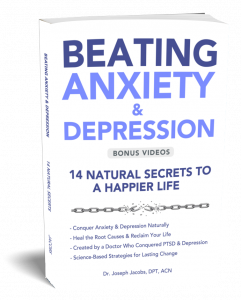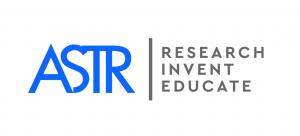The BioPsycho Therapy method that helps people get their life back without feeling numb
CLERMONT, FL, UNITED STATES, October 28, 2025 /EINPresswire.com/ — Beating Anxiety & Depression: 14 Natural Secrets to a Happier Life (ASIN: B0F6NX1QPT) is a direct challenge to the idea that anxiety and depression are life sentences. In this new release, Dr. Joseph Jacobs, DPT, ACN, cancer survivor and founder of Advanced Soft Tissue Release (ASTR), presents a clear fourteen step path to emotional relief that targets both the body and the mind. The system in this book, called BioPsycho Therapy (BPT), has been refined across years of real world work with patients ranging from professional athletes to exhausted parents, and is now being adopted in wellness clinics, mental health groups, and faith based support programs.
The book is not theory and it is not just think positive. It is built around fourteen focused chapters. Each chapter isolates a major root driver of anxiety, depression, numbness, irritability, overload, or burnout and gives practical steps to correct it.
Food and Depression breaks down how inflammatory foods and blood sugar swings can drive mood crashes, irritability, brain fog, and emotional instability. It gives readers structure for eating in a way that supports calmer brain chemistry instead of constantly spiking and crashing.
Vitamins, Minerals & Hormones Imbalance explains how deficiencies and imbalances inside the body can feel like sadness, hopelessness, panic, or rage. Readers learn how low magnesium, low B vitamins, thyroid dysfunction, and other common issues can feel like a mental problem. The message is that you are not weak. Your body may be under fueled.
Drug Induced Depression addresses something almost nobody talks about. Your mood can collapse because of your medication. The book shows readers how certain prescriptions can trigger anxiety, blunting, agitation, or depressive symptoms. It teaches readers how to have an informed and safe conversation with their prescribing doctor. It does not tell anyone to stop medication on their own, and it does not position medication as the enemy. It positions the patient as an active participant in their own care.
Brain Glitches: Your Thoughts Are Not You helps the reader separate identity from intrusive thoughts, panic stories, and catastrophic loops. Instead of saying just stop thinking that way, this chapter treats racing, repetitive, negative thoughts like electrical misfires that can be interrupted and retrained.
Distance Yourself & Zoom Out teaches emotional distancing in a healthy way. When you are overwhelmed, you do not have to merge with every feeling in real time. You can create mental space, observe what is happening, and respond instead of reacting. This is a survival tool for people who feel like they are getting pulled under by emotion.
Trauma Closure: BioPsycho Therapy (BPT) is the core of the method. Trauma is not just a memory. It lives in the body. This chapter walks through nervous system release work so the body can finally exit fight, flight, or freeze. The focus is closure, not reliving every detail. Readers also get access to companion material demonstrating how this release work looks in practice.
The Illusion of Control shows how constantly trying to manage everything and everyone keeps the nervous system in a permanent stress posture. The more you try to grip everything, the worse your body feels. This chapter reframes control as internal pressure that slowly exhausts you.
Change is the Only Constant deals with mental flexibility. Anxiety and depression get worse when the brain believes I cannot handle change. This chapter trains a different reflex. I can adjust. I can pivot. I can survive change. That shift reduces fear.
Forgiveness is presented not as excusing harm, but as releasing internal bondage. Holding rage, resentment, revenge fantasies, or unhealed betrayal keeps the body on alert and burns emotional energy. This chapter talks about how to release that weight in a way that protects you, not the person who hurt you.
Limit Screen Time looks at nervous system overload. Endless scrolling, late night blue light, nonstop stimulation, and algorithm driven outrage all wire the body for agitation and restlessness. The book gives realistic, not perfectionist, boundaries that help lower fight or flight instead of feeding it.
Declutter Your Home deals with environment as a mental health lever. Clutter, constant visual noise, piles of unfinished tasks, and chaotic rooms quietly elevate stress load and mental fatigue. This chapter gives a structure for physically creating calm so the brain can breathe again.
Simplify Your Life is about reducing input. Too many obligations, too many demands, too many musts, too many emergencies. This chapter walks the reader through cutting noise, saying no, and building margin without guilt.
Mindfulness and Meditation reframes mindfulness as nervous system training. The goal is not be spiritual. The goal is teach your body how to come out of alarm and feel safe for a moment. The practices are short and designed for people who say I cannot meditate.
Behavior Modification closes the book by giving the reader a way to act differently in real life. Change does not stick because we understand. Change sticks because we practice it in tiny, repeatable steps. This chapter shows how to build those steps into daily life so healing becomes a habit, not a mood.
Every chapter includes practical tools. You get self check questions, daily drills, and a ninety day progress framework. Readers are encouraged to track sleep quality, emotional stability, irritability, tension in the body, patience with family, and ability to feel calm without shutting down. The goal is not perfection. The goal is visible movement toward relief.
The tone of the book is direct, honest, and compassionate. Dr. Jacobs is not writing as a distant clinician. He is writing as someone who has personally fought through stage 3 cancer, trauma level stress, chronic pain, migraines, emotional overload, and physical collapse. He built these methods to survive. Then he used them with thousands of patients who were told everything looks normal even though they felt like they were falling apart.
The book does not shame medication. It does not shame therapy. It does not promise a miracle. What it promises is clarity and a plan.
Dr. Joseph Jacobs, DPT
ASTR Institute
+1 949-236-6862
email us here
Visit us on social media:
LinkedIn
Instagram
Facebook
YouTube
TikTok
X
Legal Disclaimer:
EIN Presswire provides this news content “as is” without warranty of any kind. We do not accept any responsibility or liability
for the accuracy, content, images, videos, licenses, completeness, legality, or reliability of the information contained in this
article. If you have any complaints or copyright issues related to this article, kindly contact the author above.
![]()






